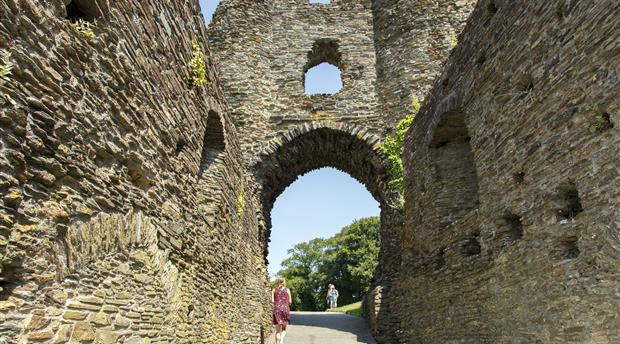This site uses cookies. By continuing to browse the site you are agreeing to our use of cookies. Read our privacy policy.
Launceston

Image by Matt Jessop - supplied by Visit Cornwall
Launceston is the chief town of a wide area lying between Dartmoor and Bodmin Moor. In Saxon times it was the site of a Royal Mint. By the 12th century the town itself had become walled (the only walled town in Cornwall) and for centuries the Assizes were housed here, in the castle itself and Guildhalls in the town.
The name Launceston is made up of Celtic and Saxon words. Lann meant church in Cornish. So it was the Lann of St Stephen. The 'ton' comes from the Saxon word 'tun' which meant farm, hamlet or estate. By the time of the Norman conquest in 1066 Launceston was an important settlement. Launceston also had a mint.
Furthermore the Normans built a castle to guard Launceston. In 1067 William the Conqueror’s half-brother Robert of Mortain was made Earl of Cornwall. He built the first castle at Launceston. The first castle was of wood but in the 13th century a stone castle replaced it. In 1227 Richard, the brother of King Henry III was made Earl of Cornwall. He built a stone castle at Launceston, much of which still remains.
The mint in Launceston seems to have closed by the 13th century. However Medieval Launceston was still an important town. It stood on the main road from Devon to Cornwall In the Middle Ages Launceston was the only walled town in Cornwall. (Today only a medieval gate remains). Launceston was the county town for Cornwall (a position it retained until 1835). However medieval Launceston would seem very small to us with a population of only several hundred.
Upcoming Events
Launceston Show - Thursday 30 July 2026
Welcome to Launceston Show.
Thank you for your interest and support in attending our Show - we are very much hoping for dry weather this year.
Offering the best day out for the family - where Town really does meet Country. We welcome you to join us and have a fabulous day. With such a wide range of events on offer there is something for everyone. A day full of FREE ENTERTAINMENT in the Main Ring on the Stage and on the Showfield. Music, entertainers, magicians, face painters, all FREE.
Come and join in whether that's a food experience with food tasting, joining in with the Young Farmers games, shopping at over 200 Trade stands or admiring the talent of our florists, rural skills that have come back into fashion, or watching the fabulous prize winning livestock. With over 200 Trade stands, there is food for tasting, handmade crafts to admire, produce grown, the list goes on. A great day out for meeting friends and feeling part of our lovely community.
Online tickets will be on sale here!
COME BACK NEXT YEAR
Advance Tickets for the 2026 Show will be available online and locally
- Early Bird Adult Ticket £15 (until week before the Show)
- From 24th July Adult Ticket: £17
- Early Bird Members Tickets: £18 available locally - see below
- Children aged 5-15 years: £5
- Under 5's to free

